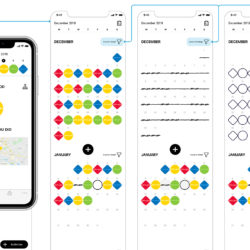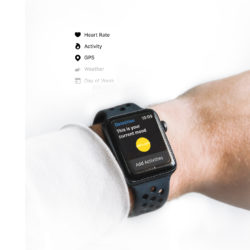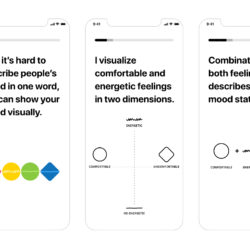Mood Planet
Description
Mood Planet is an AI mood tracking application. Mood Planet detects a user's mood states by measuring how comfortable and energetic a user feels according to the user's data from Apple Watch. It visualizes the user's mood states and supports the user in understanding the data and algorithms behind the app. The user can easily give feedback. Furthermore, Mood Planet shows the pattern between mood and the user's activities. And it gives inspiration to the user for improving their own mood. By Mood Planet, the users can be aware of their mood and reach mental well-being.What is the Topic?
In my master thesis, I studied mood trackers as an example of design considerations when artificial intelligence (AI) is applied in the context of wearables designed to help mental well‐being. I focused on what designers should consider about the relationship between machine learning and the user when creating a concept of mood tracking applications based on machine learning models. I created a clickable prototype of a mood tracking app focused on understanding the machine learning model and generating trust for the user.
Why does it look like this?
The visualization has two different dimensions: comfortable and energetic, to explain the principle behind mood measurement. The combination of the dimensions visualizes users' mood states. The mood can be objectively defined and measured along the two dimensions of feeling pleasant(comfortable) and active(energetic). The combination of both feelings describes the user's mood states. Nowadays, it is possible to measure and monitor mood by wearable devices.
What is special?
Mood data visualization interprets the app's algorithms to support the user’s understanding of the data. Comfortable and energetic feelings in two dimensions are visualized, and the combination of dimensions (both feelings) describes users' mood states. Using the combination of two dimensions helps the users not only to be aware of their mood but also users can manage AI's detection. Thus, it supports users to understand their data. I thought about not only the user's journey of the app but also AI's journey of the app. Relationship between AI and a user: how can AI not disappoint the user and build a long term relationship? Thus, not only the user is learning about themselves better, but also AI knows about a user better, so AI can provide better service for the user. Mood data visualization is an interpreter between AI and a user.
What is new?
In mood tracking apps in the current market users have to add their mood regularly to get inspiration or monitoring. My thesis's target user is young people in their 20s until mid-30s, who do not know how to express and define their feelings well compared to other age groups. Furthermore, it is not easy for my user to input data every day regularly by themselves. In my concept, users do not need to add their mood and AI tracks it. So, users do not need to add their mood by themselves regularly. Users can focus on monitoring their mood and get inspiration from it.




